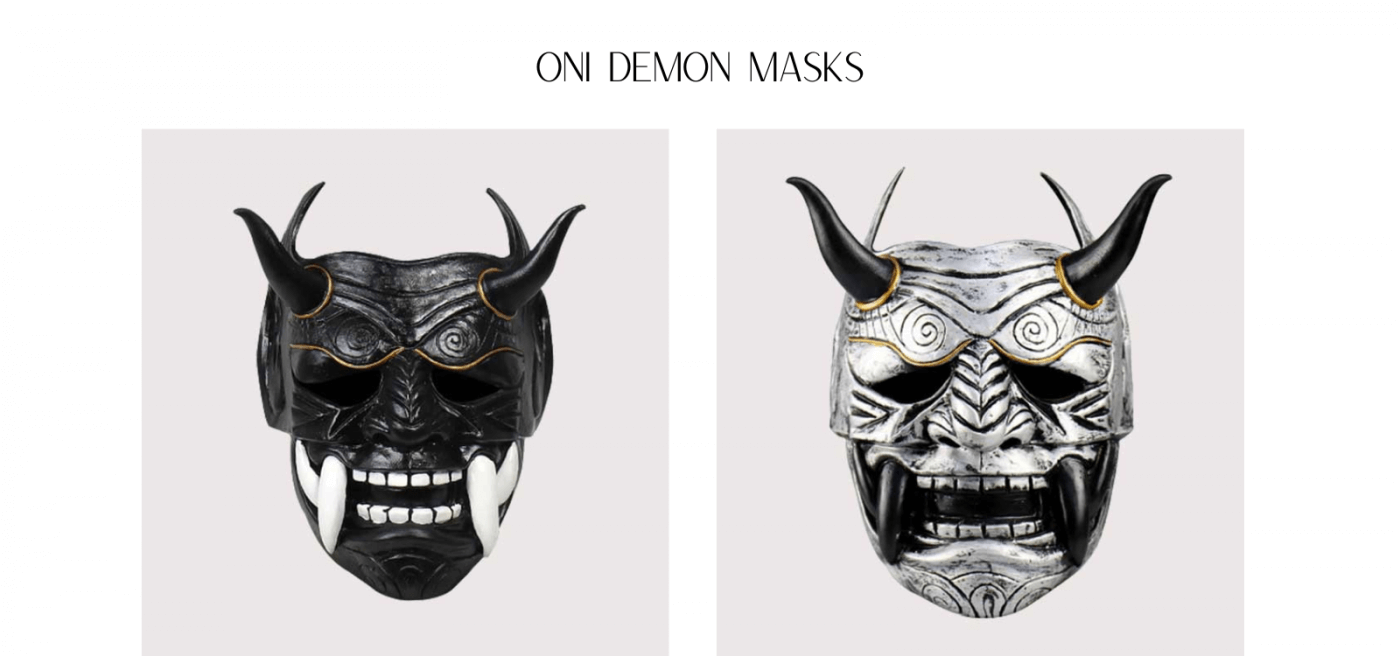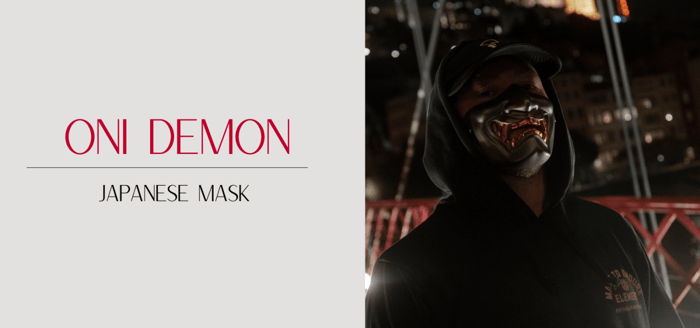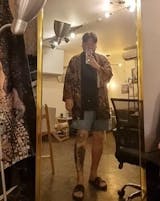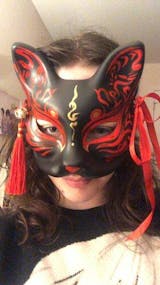About the Oni Mask also called the Japanese demon mask
Meaning changes throughout history as ideas and symbols take shape to reflect the attitudes and cultures of our modern-day world.
Oni masks constitute one powerful example of how a symbol can change over time. This emblem of Japan’s rich culture started as a representation of evil depicting demons lurking to drag departed souls into hell.
Today, however, these creatures carry a much different meaning. Once associated with the “dark side,” an Oni mask now gives its users strength and power, protecting them from danger. These masks depict red-faced Japanese demons, typically featuring two horns and an angry expression.
$54.90
Become The Centre of Attention With This Black Kimono Cardigan Step into the realm of bold aesthetics with our dynamic Kimono Cardigan, a masterpiece that marries the fierce spirit of traditional Japanese motifs with contemporary fashion flair. Tailored from top-tier… read moreBlack Oni Kimono Cardigan

$64.90
These scary Oni demons ward off evil spirits and protect their users from bad luck and harm. During Japanese festivals, people often wear Oni masks as talismans; many styles and designs exist today.
We’ll explore the different meanings, the place these masks have in Japanese folklore and culture, and their uses in Japan today.
The History of Japanese Oni Masks

Oni most likely comes from on, meaning “to hide.”
The theme of masks simultaneously depicting and concealing a person’s expression is instrumental to Japan’s culture, especially in the performances of Noh theater and Kabuki.
Oni are a type of y?kai (supernatural spirits or entities) prevalent in Japanese folklore. Initially, these entities took shape in art and folktales as evil creatures roaming the spirit world.
While their physical descriptions and depictions varied throughout Japanese culture and history, people generally portrayed them as ogres, trolls, devils, or demons.
These evil spirits or creatures typically feature disheveled hair, knife-like claws, vibrantly red or blue skin, and horns growing out of their foreheads or temples.
Artists have depicted these creatures as humanoid figures with unsettling features like three or more eyes. An Oni devil may wear a loincloth made from tiger skin.
Oni also usually carry an iron club called a kanab?. In addition to being gruesome devils wielding powerful blunt weapons that could inflict massive harm on anyone who stands in their way, Oni are masters of deception and disturbing the world’s peace.
People once thought Oni created natural disasters, diseases, wars, and more. They also believed that Oni could change their forms to kidnap and eat humans.
Originally thought to be invisible, their depiction and attitude in Japan began to change. As their representations became more humanized and less ghost-like, actors began portraying Oni in Noh theater by wearing the appropriate masks with bright red or blue faces.
While the design could vary with each performance, the Oni almost always resembled evil spirits or demons.
What Do Oni Masks Represent?
$44.90
Wear the Legend—Rule the Night with the Japanese Oni Mask Unleash the power and mystique of ancient Japanese folklore with the Japanese Oni Mask—a striking piece of wearable art that fuses tradition with an unapologetically bold edge. Inspired by the… read moreJapanese Oni Mask

Besides representing evil spirits, the Japanese Oni mask meaning typically carried four crucial elements:
Fear: There’s no denying how fearful Oni can appear. While today, their symbolism signifies good fortune, historically, the general populace blamed Oni for significant calamities like war and violent weather.
Deception: Some Oni could transform into beautiful male or female forms and gain the trust of their victims before devouring them.
Vengeance: Many scholars believe the Oni originated in Hindu and Buddhist mythologies, including such creatures as the Yakshas and Rakshasas. These demigods or spirits, at their worst, would devour humans. As Oni, their responsibilities were to find sinners and dole out sentences set by the ruler of hell, King Yama.
Hatred: In Japanese folklore, some stories depicted these creatures as evil humans beyond forgiveness who would transform into Oni after they died. Additionally, very wicked humans could transform into these scary demons while alive.
Although Oni has a solid link to religious beliefs and customs, there’s also the theory that Oni symbolizes humanity’s dark side.
Why Were Oni Masks Worn?
As the culture changed, the symbolism behind Oni masks followed suit. Today, people use Oni masks to ward off evil, parades and marches being prime examples. Of course, anime, manga, and video games also profoundly impact modern perceptions of Oni masks.
We’ll now explore two critical uses of Oni masks in the contexts of traditional theater and samurai warrior culture.
Oni Masks in Theater
Besides Oni, Japanese art and theater use masks to showcase various other characters, each with a specific thematic and moral purpose.
For example, while actors wear masks to hide their expressions, each is expertly carved to catch certain angles of the stage’s light to change how the audience views the mask and the character at key moments in the story.
In Noh theater, Hannya masks can produce various emotional expressions depending on how the stage lights hit them. Sometimes confused with Oni masks, Hannya masks evoke female demons consumed by jealousy.
If the actor wearing such a mask peers directly into the audience, they might see an angry face. However, if the actor looks at the ground, the reflected light might give the illusion of crying.
When comparing the Hannya mask with the Oni mask, we can see many similarities. The main difference between them is that an Oni mask represents a male demon while a Hannya mask represents a female one.
Typically, the redder the mask, the more evil both creatures are. Besides Oni and Hannya, many other masks and characters exist in Noh theater, such as:
Kitsune
Namahage
Okame
Hyottoko
Tengu
Traditionally, around 60 different types of Noh masks existed, but today, this number is much higher. Some masks represent general characters, while others represent specific characters within Japanese popular media.
These masks initially represented certain gods within Shintoism or symbols of Japanese culture.
Although a big staple in theater, festivals, and Japanese life and culture, Oni masks have served other purposes beyond portraying evil spirits.
Did Samurai Wear Oni Masks?
Samurai wore masks resembling demons to protect their faces from damage and strike fear into the hearts of their enemies. The umbrella term for these masks is men-yoroi (also called menp?), which could take many forms. Some fully covered a samurai’s face, while others only partially covered their faces.
These masks typically consisted of iron or metal with elaborate designs or detailing that could feature wild hair or detachable noses.
Although most of the masks resembled devils, wild animals, or demons to frighten their enemies, there is debate about whether or not they represented Oni, per se.
At the very least, samurai wearing these masks in Japan likely borrowed inspiration from Oni symbolism. Either way, at its core, the idea of men-yoroi was to protect the samurai while intimidating enemies.
Oni Masks in Recent Times
Originally, artists represented Oni as evil spirits with immense power capable of inflicting terrible harm. As harbingers of death and causes of wars, diseases, and natural disasters, they gave society at large a focal point for its anxieties. In that sense, they have served a somewhat therapeutic cultural purpose.
When actors wearing masks in Noh theater sought to represent Oni as evil entities, they also emphasized how integral such creatures were to Japanese religious beliefs and practices.
However, as time passed, the deep meaning behind Oni masks started to shift. For example, as early as 1680, priests would wear Oni masks to help them summon birdlike entities known as tengu.
As the viciousness associated with Oni subsided in Japan, they became integral to festival celebrations.
For example, the Setsubun Festival on February 3rd involves people throwing soybeans out of their windows to ward off Oni. While doing so, they chant “Oni wa soto! Fuku wa uchi!” (“Out with demons! In with fortune!”)
Many other Japanese phrases, idioms, and proverbs reference Oni. Japanese parents may use these phrases or stories to correct a misbehaving child.
A game played by Japanese school children known as onigokko is similar to the game of tag in the Western world. The main difference is that whoever is “it” assumes the role of “Oni.”
Oni Masks Today
Oni masks continue to impact life in Japan significantly, but instead of symbolizing evil, they are efforts to ward off bad luck.
Their depictions in modern art and stories are widespread, including in novels, anime, manga, and video games. Oni tattoos, jewelry, and face masks are still prevalent.
Oni Mask Tattoos
Many people in Japan and worldwide choose to get a traditional Oni mask tattoo or related design with a more modern flair.
Oni mask tattoos can represent different ideas for different people, but they typically serve one of the following purposes:
Warding off bad luck or omens
Bringing great fortune in any circumstances
Instilling fear in potential enemies and keeping them at bay
Choosing to get an Oni tattoo complete with traditional black ink or decorative colors is a significant undertaking, but the results are breathtaking.
Oni mask tattoo meanings vary for each person. They can be a way to show appreciation for Japan’s rich culture, ward off evil, or even direct and broadcast your competitive spirit to those around you.
Two significant Oni tattoo designs people often get are as follows:
Oni mask and snake tattoo: Oni tattoos with snakes often symbolize good luck, protection against evil, strength, wisdom, and change. People usually pair a snake tattoo with a Hannya mask instead of an Oni mask.
Oni mask and dragon tattoo: Traditionally, a dragon in Japan is a powerful creature that uses its power to do good. Pairing a dragon tattoo with an Oni tattoo may represent a person’s internal struggle of doing good versus bad.
Many people also choose to get Oni tattoos with flowers to create an exciting contrast between something fearful and something docile and beautiful.
While an Oni makes for an intricate and striking tattoo design, getting an Oni mask tattoo is also a huge commitment. While today, an Oni tattoo is more accessible to everyday citizens, it’s still important to consider your intentions behind receiving one.
Do Oni tattoos have significant importance to you, or do you just like their design? Luckily, other avenues exist if you want to show appreciation without committing to an Oni mask tattoo.
Other Uses Besides Getting an Oni Mask Tattoo
Besides getting an Oni tattoo, you can pay homage to these fascinating creatures by making or buying an Oni mask. Oni masks can be great for:
Use in festivals or parades: If you find yourself in Japan or have the chance to participate in a Japanese-style festival near where you live, an Oni mask can be a great addition.
In cosplay or at a costume party: Whether you’re playing a specific character or not, an Oni mask is sure to impress people the next time you cosplay or go to a costume party. A professionally designed and tastefully worn Oni mask will bring creativity and flair to your costume.
Halloween: Whether for your kids going door to door asking for candy or as part of a Halloween party, an Oni mask makes a big impression. Just be sure to find one that fits well. Dress up like an anime character or someone from a traditional Noh theater performance.
Hanging as decoration: Maybe you love how Oni masks look but don’t necessarily want to wear one. You can also use an Oni mask as decoration. This visual art piece will make any room pop, and you can hang it on your wall or door to scare away bad spirits. Include some interesting Oni mask quotes or tasteful accessories for more impact.
Start Your Oni Mask Collection Today
Knowing how to make an Oni mask at home can be a fun and creative project. People typically use cloth, wood, leather, latex, or porcelain to make Oni masks.
However, papier-mâché with a wig and acrylic paint is also an option. Many people use a pair of cheap vampire fangs to evoke the Oni’s characteristic teeth.
While papier-mâché is a cost-effective option and works great as a project, if you want a professionally designed Oni mask to wear, then our Eiyo Kimono team can help.
We have various Oni, Hannya, and samurai masks that look like the real deal when worn while being affordable. In addition, you can choose between full-face and half-face masks.
Discover our Oni masks and other products by contacting Eiyo Kimono today!






